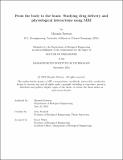From the body to the brain: Studying drug delivery and physiological interactions using MRI
Author(s)
Dawson, Miranda
DownloadThesis PDF (18.47Mb)
Advisor
Jasanoff, Alan
Terms of use
Metadata
Show full item recordAbstract
The brain is in continuous communication with the rest of the body. Nerves connect the peripheral and central nervous system, and complex vasculature networks selectively permit passage of small molecules with an exogenous origin into the brain parenchyma. Although brain-body interactions underpin a host of cognitive and physiological phenomena, they are often overlooked in studies of brain biology and mental function. We studied aspects of the interaction between brain and body using functional and molecular magnetic resonance imaging (MRI), in combination with other tools. In a first project, we examined properties of the blood-brain barrier (BBB). The BBB is a highly selective collection of endothelial cells and tight junction proteins that restrict passage of extracerebral substances from the blood vessels into the brain tissue. We disrupted and bypassed the BBB to deliver an MRI contrast agent and quantitatively assessed the resulting contrast dynamics. We discovered that individual brain regions display method-independent susceptibility to BBB disruption and washout, suggesting principles for calibrating drug delivery and understanding the propensity for chemical exchange across the BBB. We then used one of the widefield brain delivery techniques to apply a novel contrast agent for the study of the cholinergic system, a neurochemical pathway important for motor control mechanisms in both the central and peripheral nervous systems. Kinetic modeling of probe distributions revealed intrinsic localization of cholinergic enzymes. Finally, we applied related neuroimaging tools to an animal model of substance abuse, a pathology for which brain-body interactions are particularly engaged but underappreciated. We designed a study to investigate the role of the insula, a cortical mediator of peripheral physiological signals, in responses to opioid exposure. With molecular imaging approaches, we show the insula shapes drug-dependent brain phenotypes and physiological responses during substance exposure and withdrawal. In all, this work serves as a demonstration of the power of quantitative neuroimaging methods for multifaceted investigation of brain and body relationships.
Date issued
2024-09Department
Massachusetts Institute of Technology. Department of Biological EngineeringPublisher
Massachusetts Institute of Technology